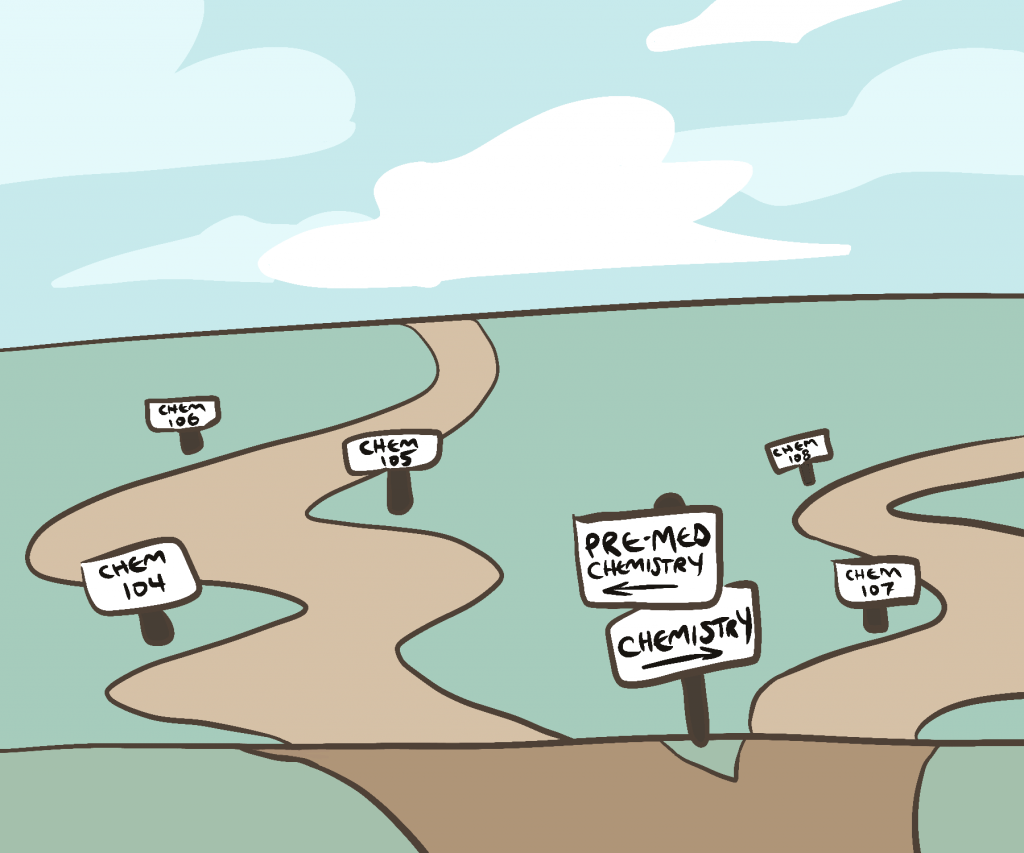Chemistry 101: Introduction To Chemistry is one of the most commonly taken courses at Binghamton University because of the multitude of requirements it fulfills, whether for a particular major, a general education requirement or as part of the required pre-health curriculum. However, pre-health students will now have another option to fulfill this requirement, with new pre-health-centered introductory chemistry classes.
Currently, general chemistry at BU is comprised of two courses: Chemistry 107: Introduction to Chemistry Principles I and Chemistry 108: Introduction to Chemistry Principles II. The recent change will create a new three-class sequence: Chemistry 104: General Chemistry I, Chemistry 105: General Chemistry II, and Chemistry 106: General Chemistry Laboratory. Chemistry 104: General Chemistry I and Chemistry 105: General Chemistry II will serve as the lecture portion of the sequence, and Chemistry 106: General Chemistry Laboratory will serve as the laboratory portion of the class. Currently, Chemistry 107: Introduction to Chemistry Principles I and Chemistry 108: Introduction to Chemistry Principles II include a lab portion.
According to Alexsa Silva, director of instruction and outreach in the chemistry department, there were multiple motivating factors behind the decision to create new pre-health chemistry courses.
“Last year our largest course, sequence [Chemistry 107: Introduction to Chemistry Principles I] and [Chemistry 108: Introduction to Chemistry Principles II], had more than 1,000 students enrolled,” Silva wrote in an email. “It became clear to us that, instead of just opening another section, we have to analyze who is taking the class and if they would benefit from a different course altogether.”
Christof Grewer, undergraduate program chair and professor of chemistry, said Chemistry 106: General Chemistry Laboratory, the lab portion of the sequence, can be taken either in the spring or fall semester.
“It will provide more flexibility for students as to when to take the lab component,” Grewer wrote in an email. “Transfer of credit from other institutions that have two lecture and one lab systems will be much more straightforward.”
According to Silva, there will be some differences between the pre-health and non-pre-health chemistry courses, although they will both provide a strong foundation in chemistry for students.
“There will be many similarities between the two courses, particularly on their primary learning objectives,” Silva wrote. “Both [Chemistry 104: General Chemistry I] and [Chemistry 107: Introduction to Chemistry Principles I] and [Chemistry 105: General Chemistry II] and [Chemistry 108: Introduction to Chemistry Principles II] will comprehensively cover all topics in general chemistry and will prepare students for their future coursework and careers. Both sequences will have the same final exams. The new sequence, [Chemistry 104: General Chemistry I] and [Chemistry 105: General Chemistry II], will explore how chemical principles relate to biological and medical applications.”
Both Grewer and Silva said the desired outcomes for these changes are both logistical and academic.
“The expected outcome for students is much higher flexibility in terms of course selection, easier transfer of credit from other institutions and largely reduced waiting lists for lab courses,” Grewer wrote.
Silva echoed this statement and said the change will focus on benefiting students’ pursuit of careers.
“These changes are meant to bring about a more personally enriching environment for students to apply their coursework and knowledge to fields related to their career of interest,” Silva said.
However, some pre-health students, like Evelyn DeVoesick, a sophomore majoring in biochemistry, have mixed feelings about the changes. DeVoesick said she thinks one reason for the change is to highlight students’ lab experience while applying for medical schools.
“I think there are pros and cons to the changes,” DeVoesick said. “I understand why they made this change and I’m all for smaller class size. I agree that medical schools want to see labs separately. I think it might be difficult for freshmen that are undecided, though, because it can be difficult to switch up classes once you’ve registered.”
DeVoesick said she is also concerned that the quality of the pre-health chemistry class may become inferior to that of Chemistry 107: Introduction to Chemistry Principles I and Chemistry 108: Introduction to Chemistry Principles II.
“When you start making a class pre-health it can sometimes get dulled down,” DeVoesick said. “For example, the pre-health biochemistry class is considered easier than the standard biochemistry class. I believe that if you’re a pre-health student you should be held to a higher standard.”
Sonali Patel, a sophomore double-majoring in biology and business administration, said she is also ambivalent about the changes.
“I liked how [Chemistry 107: Introduction to Chemistry Principles I] and [Chemistry 108: Introduction to Chemistry Principles II] was structured when I took it and given the option, I don’t think I would’ve taken pre-health introductory chemistry,” Patel said. “I think that this could be a good change if the pre-health chemistry classes actually focus on chemistry as it relates to medicine.”
According to Grewer, the new Chemistry 104: General Chemistry I, Chemistry 105: General Chemistry II and Chemistry 106: General Chemistry Laboratory sequence will be offered for the first time in summer 2020.



